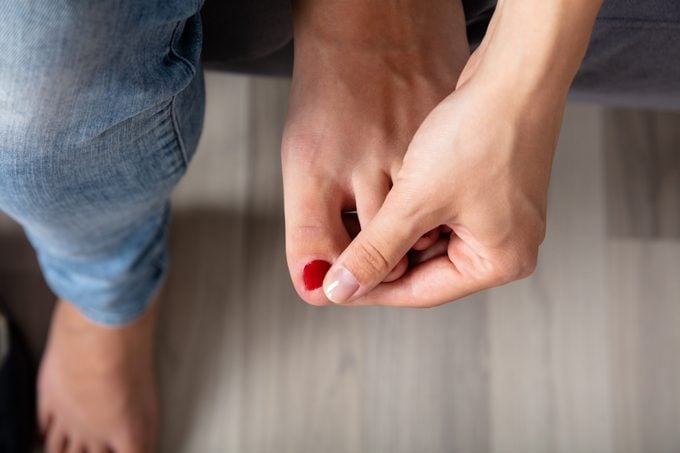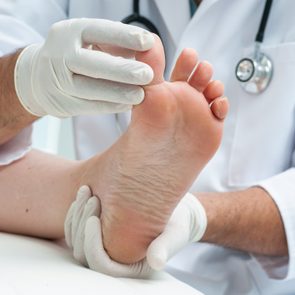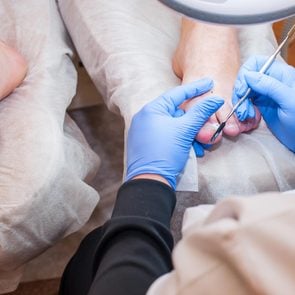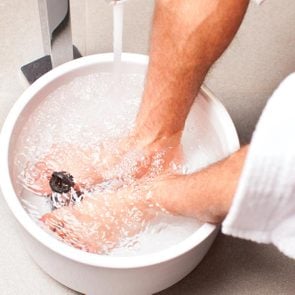Do Your Toenails Seem Too Thick? Here’s Why—and What to Do
Updated: Mar. 28, 2022
If your toenails seem thicker than usual, it may indicate a fungal infection or an underlying condition. Check out these expert-approved solutions.
Why are my toenails thick?
You’re probably not staring at your feet every day, especially during frigid seasons when they go from one pair of socks to another. Which is why thickened nails can come as a surprise. Chances are, you noticed the change when attempting (and possibly struggling) to clip them. Thickened toenails are often just a fun part of aging, like getting skin tags, dark spots, and wrinkles.
But what if your toenails are thick and come with other issues, like a yellow tint and curve of the nail, or redness and swelling of the surrounding skin? Toenails (and fingernails, for that matter) can give clues to your overall health status. And thickening toenails might be trying to tell you something is amiss.
Here are some reasons why you might have thick toenails, the other signs that show up with them, and what you can do about them.
Onychomycosis
A toenail fungal infection, or onychomycosis, is one of the most common causes of thick toenails. A fungus can enter under or beside the toenail or through a break in the skin. It can occur when foot fungus, such as athlete’s foot, travels to the toenail. The infection may take hold when your feet spend too much time in sweaty and tight shoes or from walking barefoot in moist and warm areas, like locker rooms and pool decks.
What happens to the toenail?
The toenail becomes thick and discolored. Depending on the type of fungus, it could have patchy white spots, a yellowish tint, or a yellowish-brown color. The nail may become brittle and lift from the nail bed. It’s often painful. (Here are other potential reasons you have yellow toenails.)
Treatment
Toenail fungus usually requires medical attention. Typically, you’ll treat toenail fungus by applying a prescription-strength antifungal polish to the toenail and taking prescription antifungal pills. If medication doesn’t work, your doctor may need to remove part or all of your toenail.
(To soothe your symptoms, try a foot soak for toenail fungus.)
Psoriasis
Nail psoriasis is a common inflammatory condition, and it occurs in 80 to 90 percent of people with plaque psoriasis. “Nail psoriasis often causes pain and impacts daily activities, and patients have aesthetic concerns,” says Shari Lipner, MD, associate professor of clinical dermatology at Weill Cornell Medicine in New York City.
What happens to the toenail?
Toenails will appear thick, with a yellowish discoloration and tiny indentations called pits. The nail may also lift from the nail bed.
Treatment
There are no effective over-the-counter treatments for nail psoriasis—creams and ointments can’t penetrate the nail. “Often patients will need injections or oral medications,” says Dr. Lipner. These might include prescription corticosteroids, injections of corticosteroids, certain retinoid creams applied to the nail, or psoriasis medication. It’s also a good idea to keep the nails short and avoid trauma to the nails.
Paronychia
Paronychia is a tender infection or inflammation that appears around the nail fold base (the area near the cuticle). It may happen when bacteria or fungus invade the skin. Other risk factors are poor blood flow to the toes, diabetes, and having a compromised immune system.
What happens to the toenail?
Redness and inflammation will appear around the base of the toenail, and it’s often tender to the touch. Tiny, pus-filled pockets might occur under the cuticle. The toenail (and other nails) can become thick, distorted, and ridged as they grow.
Treatment
A painful infection with pus warrants a visit to the doctor. You’ll likely receive a prescription for an antifungal cream to use a couple of times a day for a few months. If paronychia is severe, your doctor may also prescribe an antifungal pill to tame the infection faster.
Onychogryphosis
This mouthful of a medical term is commonly referred to as ram’s horn nails because the nails thicken and become curvy. (Like the horns of a ram—hence the name.) “Onychogryphosis is an underlying disorder of the nail plate growth,” says dermatologist Pooja Sodha, MD, director of cosmetic dermatology at George Washington Medical Faculty Associates in Washington, D.C.
It usually targets the big toes. Older adults and people with poor oral care are more prone to Ram’s horns nails. It can also run in families. People with diabetes and circulation problems may have an increased risk of ram’s horn nails.
What happens to the toenail?
You’ll notice significant thickening of the nail, with an opaque, yellow-brown discoloration. You won’t wake up with a gnarly ram’s horn overnight. Curled “horn” nails only happen if the condition is left untreated for a significant period of time.
Treatment
Ram’s horns can be quite painful and should be diagnosed and treated early. “Patients may develop secondary nail infections and onychomycosis [a toenail infection], and it may be associated with painful ingrown toenails,” says Dr. Sodha. Initial treatment focuses on reducing the thickening and curvy nail growth.
A podiatrist or dermatologist will probably use clippers, burs, and drills, along with products like over-the-counter urea cream to soften the nail. Next, a doctor will address the underlying cause, such as psoriasis or a toenail infection, and treat it.

Repeated trauma and injury
“Chronic trauma to the nails from running, sports, or poorly fitting shoes often results in thicker toenails over time,” says Dr. Lipner. The sport itself doesn’t cause the thickening; repeated rubbing and bumping of the toenail against the inside of your shoes does. Stubbing your toe or dropping a heavy object onto it can also contribute to a thickened toenail.
What happens to the toenail?
Besides getting thicker, it hurts—at least immediately after an injury. Repeated trauma, like running, might not hurt at all. The nail becomes discolored, usually black and blue. A blood blister may form under the nail. Both scenarios can cause the nail to lift and separate from the nail bed.
Treatment
Prevention is the best way to avoid thick toenails from trauma and injury. And while you can’t prevent an injury from accidentally happening to your toenail, you can ward off repeated trauma by wearing properly fitted shoes. A professional fitting may in order, especially if you are a new runner. Be sure to wear socks that wick away moisture, and use foot powder for sweating. Both can help prevent fungal infections, an entirely different cause of thick toenails.
It may be tempting to pull off a nail that is lifting from the nail bed—but resist the urge. Keep the nail trimmed, wear a toe protector for comfort and let the nail fall off naturally. If a blood blister appears under the nail, don’t pop it. Doing so could cause more damage or lead to infection. Call your doctor to treat it.
Aging
Toenails don’t always get thicker as we age. They may actually get thinner or remain the same, Dr. Sodha says. If changes occur, it’s likely due to a few things: reduced blood flow to the toes, nail care habits such as filing or buffing, trauma, or improperly fitting footwear.
Slightly thicker toenails don’t pose any immediate risks to your health, but they are harder to trim. And when toenails are harder to trim, you might accidentally cut them too short or pierce the skin, leaving it vulnerable to infection or fungus. (That’s extra dangerous if you have diabetes.) Include the nail-care basics below in your ongoing toenail-care routine.
How to prevent thicker toenails
While cutting your toenails seems pretty basic, there’s more to it than you might think. To help keep your toenails in good shape, follow the steps below to make it easier to cut thicker toenails and help prevent fungus and ingrown toenails.
Soften the nails
If possible, trim your nails after a shower or bath. Or soak them a few minutes in lukewarm water first. You can also soften them the night before you clip them. Before bed, apply Vaseline, Eucerin, or Aquaphor to your feet. Cover them with socks, get some shut-eye, and wake up with softer nails.
Use proper tools
Always use nail clippers for fingernails and toenail clippers for toenails. Disinfect clippers monthly (or after someone else used them). Soak a small scrub brush in a bowl of 70 to 90 percent rubbing alcohol for about five minutes. Use the brush to scrub the clippers, then rinse in hot water. Be sure the clippers are completely dry before using or storing them.
Cut straight across
Don’t try to taper the side of your nails by cutting sharp angles. Doing so encourages the toenail to grow into the skin, inviting a painful ingrown toenail.
Leave your cuticles alone
Cuticles serve an important purpose in protecting the nail root from bacteria and germs. Don’t cut or push them back.
Moisturize
Moisturize after trimming. Apply a thick moisturizer, such as Eucerin or Aquaphor, daily or after bathing.
Next, learn about common foot problems and podiatrists’ solutions.






















